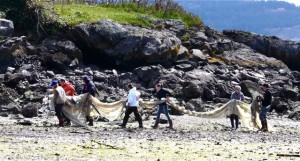
Volunteers and community marine scientists help with a fishing net at Indian Island Marine Helath Observatory in April this year. Photo courtesy of Susan Slapin
The upcoming low-tide window July 29-31 will be the last big research-and-outreach event of 2011 for the Indian Island Marine Health Observatory.
Kwiáht Director Russel Barsh says, “Hard to believe, but we have already had teams for 25 days and 2 nights on the beach this year! And collected reams of data.”
The data was submitted to Kwiáht, BeachWalkers and Community Scientist volunteers showing the differences in bivalve species and abundance between gravel and silt test pits analyzed.
“Dominance overall of steamer clams is quite clear as well,” said Barsh. “The age-distribution charts … show that steamers have had two big reproductive (“recruitment”) events in the past 20 years: in 2002 and 2008. The next most abundant species, bentnose clams, had one big spawn in 2005. As we noted last year, butters are not doing very well.”
Workers with the Marine Health Observatory will provide outreach at Indian Island on Saturday, July 30,describing the area’s botany and birds. Others will talk to visitors on the tombolo and along the island’s rocky shoreline between 10:30 a.m. and 12:30 p.m.
Barsh hopes to begin conducting invertebrate surveys (far rocks, and meter-squares) on Friday July 29 and fishing on Sunday, July 31. To inquire about the weekend’s projects, contact Barsh at rlbarsh@gmail.com.
(More information about the Indian Island Marine Observatory is available at www.indianisland.info)
**If you are reading theOrcasonian for free, thank your fellow islanders. If you would like to support theOrcasonian CLICK HERE to set your modestly-priced, voluntary subscription. Otherwise, no worries; we’re happy to share with you.**







